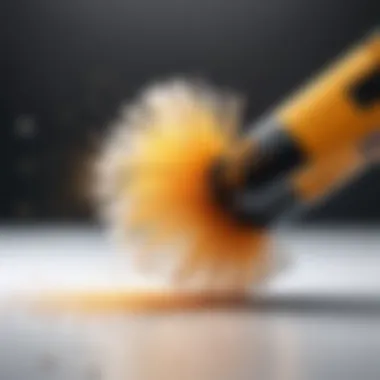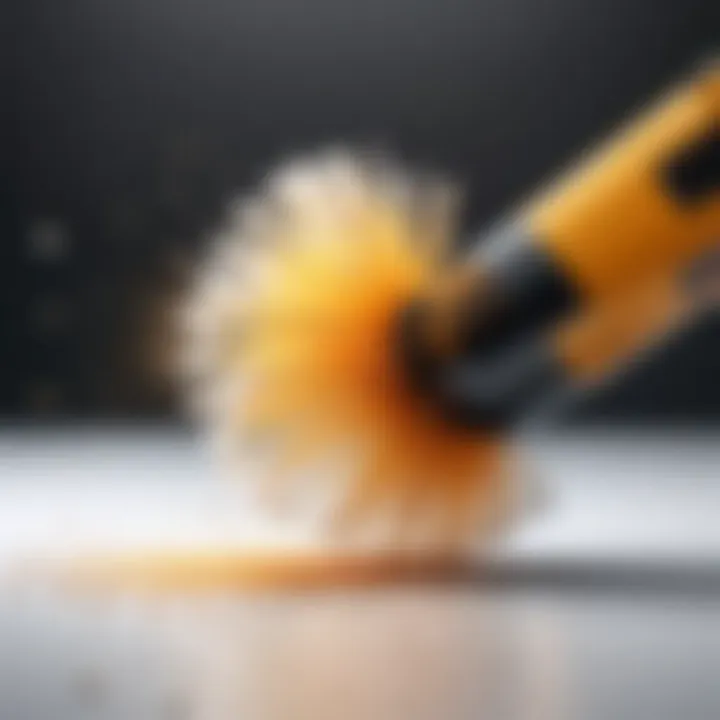Examining the Static Duster: Design, Use, and Impact


Intro
The static duster has become a staple in many homes and workplaces. It offers an efficient solution for cleaning various surfaces without the need for liquids or chemicals. This article comprehensively explores the static duster, diving into its design, functionality, and market reception. By analyzing consumer experiences and practical applications, readers can make informed decisions regarding this cleaning tool. Understanding its specifications, performance, and usability can lead to better choices that suit individual needs.
Technical Specifications
Detailed Product Specs
The static duster typically features a lightweight design, often crafted from microfiber or synthetic materials. Its head is often fluffy or knitted to effectively attract and hold dust and debris through static electricity. Many models have extendable handles, allowing users to reach high places with ease. Some dusters even come with replaceable or washable heads, adding to their longevity and efficiency.
Performance Metrics
Effectiveness is measured by the amount of debris captured and retained. Reviews often highlight that good static dusters can catch fine particles and larger dust residues without leaving streaks or residue behind. The ease of maneuvering and weight of the duster impacts user satisfaction greatly, with lighter models generally preferred for prolonged use.
Compatibility Information
Static dusters are versatile tools that work well on a range of surfaces such as wood, glass, and electronics. However, they may not be suitable for wet or heavy cleaning tasks. Users should consider their specific cleaning needs to choose the appropriate product.
Product Comparisons
Feature Comparisons
When comparing static dusters, consider features like length and width of the handle, material quality, and head design. Some brands provide ergonomic handles, while others focus on eco-friendliness with biodegradable materials.
Price Breakdown
Pricing can vary greatly. Entry-level models may cost around $10, while more advanced options from brands like Swiffer or O-Cedar can be priced over $30. The decision on investment often depends on frequency of use and required features.
User Experience Breakdown
User experiences vary, but many consumers appreciate the quick and effective dusting capability. Reviews highlight that many models are useful for everyday use, while some high-end products excel in niche applications like delicate electronic cleaning.
Practical Applications
Use Cases for Different Users
Different users find varied applications for static dusters:
- Homeowners: Ideal for quick clean-ups in living areas.
- Office Workers: Useful for keeping workstations dust-free.
- Tech Enthusiasts: Great for dusting computers and electronics safely.
Recommended Configurations
Using the duster with an extension pole often enhances reach. For intricate spaces, a smaller model is preferable.
Multi-Platform Performances
Compatible across various environments, static dusters can perform well in homes, offices, and workshops, maintaining their effectiveness regardless of setting.
Latest Trends
Industry Developments
Recent trends focus on sustainability. Many manufacturers are moving towards eco-friendly materials and designs, catering to the growing demand for green cleaning products.
Emerging Technologies
Technological advancements include electrostatic technology improvements to enhance dust capture efficiency. Some brands are also integrating sensors to alert users when the duster needs cleaning or replacing.
Future Predictions
The future direction indicates an increase in smart dusters that integrate with home automation systems, ensuring homes remain clean with minimal effort from users.
Buying Guides
Recommended Products
For those entering the market, consider reliable brands such as Swiffer, O-Cedar, or Scotch-Brite for quality results.
Purchasing Tips
- Identify specific cleaning needs before choosing a model.
- Look for products with replaceable heads to improve sustainability.


Warranty and Support Information
Many brands offer warranties, which can vary from one year to lifetime guarantees on durability. It's essential to read the terms before purchase for full understanding.
Understanding the features, specifications, and user experiences of the static duster can greatly enhance your cleaning efficiency. Choose wisely to ensure you meet your specific needs.
Overview of the Static Duster
The static duster has gained traction as a modern cleaning tool that promises efficiency and ease of use. It is essential to understand its significance within this article. Understanding the static duster will allow users to make informed choices in their cleaning routine, enhancing overall satisfaction in product usage.
Concept and Purpose
The concept of the static duster revolves around its ability to attract and capture dust particles through static electricity. This design addresses a key challenge in cleaning: effectively removing dust without scattering it back into the environment. The primary purpose of this tool is to simplify the dusting process, catering to a variety of surfaces like electronic devices, furniture, and even delicate items. Users appreciate its lightweight design, making it a practical solution for everyday cleaning tasks. It offers distinct advantages over traditional dusting methods, which can often leave residues behind or require excessive physical exertion.
Historical Context
The static duster emerged as a response to evolving cleaning needs. Traditional methods like feather dusters or cloths had limitations in dust retention. With advancements in materials and technology, products like the Swiffer Dusters entered the market in the 1990s. They introduced a new paradigm in the way we approach dusting, shifting focus towards more effective, user-friendly designs. The introduction of synthetic materials facilitated the creation of static dusters, allowing for improved functionality and efficiency in cleaning. This historical evolution underscores an effort to enhance user experience and cleaning effectiveness, which remains relevant today as consumers look for more effective cleaning solutions in a fast-paced life.
As cleaning technology continues to evolve, understanding the static duster provides insight into how design and functionality can significantly impact cleaning efficiency.
Design Features of the Static Duster
The design features of the static duster play a crucial role in determining its functionality and overall effectiveness. The combination of materials and principles of ergonomics facilitate not just the cleaning process but also the users' experience while employing the tool. Understanding these aspects allows consumers to appreciate how these elements contribute to a more efficient cleaning routine.
Materials Used
The materials selected for constructing the static duster are essential for its performance. Traditional dusters often use feathers or cotton, but modern static dusters typically incorporate synthetic fibers. These fibers can be engineered to attract and hold dust particles effectively.
- Microfiber: This is a common choice for many static dusters. Microfiber can capture particles smaller than what conventional materials can, making it highly efficient in dust removal.
- Plastic: Some handle designs utilize lightweight plastic materials to enhance durability while keeping the overall weight manageable for extended use.
- Electrostatic Materials: Certain dusters utilize specially designed materials that create an electrostatic charge, allowing better dust attraction.
These materials not only aid in efficient dusting but also help in reducing the wear and tear that comes from traditional materials. Proper material selection is a defining characteristic of the static duster’s effectiveness.
Ergonomic Design
The ergonomic design of the static duster is crafted with the intention of making cleaning simpler and less physically taxing. This focus on user-friendliness can be seen in various aspects:
- Grip and Handle: Many static dusters come with contoured grips that provide comfort and stability during use. A well-designed handle reduces strain on the wrist and allows finer control.
- Length and Reach: Today's dusters often feature adjustable lengths, making it easy to reach high or difficult spots without needing a ladder. This flexibility is significant for comprehensive cleaning.
- Weight Distribution: An effectively balanced design means less effort is required to dust areas. This aspect ensures that users can clean for longer periods without discomfort.
The ergonomic features significantly enhance the user experience, allowing for intuitive and fatigue-free cleaning.
In summary, the design features of the static duster—its materials and ergonomic considerations—are key to its success as a household cleaning tool. These elements not only impact cleaning efficiency but also shape the user experience, making it more pleasant and effective for a variety of cleaning tasks.
Functionality and Cleaning Mechanism
Understanding the functionality and cleaning mechanisms of the static duster is crucial. These factors determine how effectively the tool removes dust and debris from various surfaces. Static dusters utilize an innovative approach that capitalizes on static electricity, making them unique compared to more traditional cleaning methods.
Benefits of utilizing static cleaning methods include:
- Effective Dust Attraction: Static electricity allows dust particles to be attracted to the duster, resulting in efficient cleaning.
- Reduced Environmental Impact: Using a static duster often requires no additional cleaning solutions, contributing to a more eco-friendly cleaning practice.
- Versatility: Static dusters can be used on a variety of surfaces without the risk of scratching or damaging them, making them ideal for delicate objects.
This section will further explore how static electricity operates and the specific applications of static dusters across different surfaces.
How Static Electricity Works
Static electricity is a fascinating phenomenon. In simple terms, it is the accumulation of electric charge on an object's surface. When materials come into contact, electrons can be transferred, leading to one object being positively charged and the other negatively charged. Static dusters are designed from materials that can build up this charge. These materials, such as microfiber or synthetic fibers, attract dust particles when activated by friction against surfaces.
When you swipe a static duster across an area, it builds up a static charge. This charge creates a temporary attraction to dust and small particles. The efficacy of this mechanism means that a static duster can clean effectively without the need for sprays or chemicals, which is an important consideration for those concerned about indoor air quality or chemical exposure.
It is essential to note that high humidity can reduce the effectiveness of static cleaning. Atmospheric conditions can affect the level of static charge that develops on the duster. Therefore, when using it, consider the environment in which you are cleaning. In dry conditions, the duster performs optimally.
Applications for Different Surfaces
Static dusters are remarkably versatile due to their design and cleaning mechanism. They can be employed on various surfaces, maximizing their utility in different contexts. Here are some common applications:
- Electronics: Static dusters are ideal for electronic devices. They can clean keyboards, screens, and interior components without the risk of scratches or damage.
- Furniture: Wooden surfaces benefit from the gentle yet effective dust removal provided by static dusters. Unlike wet cleaning methods, they do not introduce moisture, which can harm wood finishes.
- Delicate Items: Items such as picture frames, sculptures, and collectibles require careful cleaning. Static dusters provide a safe option for removing dust without the risk of abrasion.
- Hard-to-Reach Areas: The flexibility and design of static dusters allow you to clean in tight spaces, such as blinds, ceiling fans, and behind appliances.
In summary, understanding how static electricity works and recognizing the various surfaces on which static dusters can be applied provides valuable insight into their functionality. This knowledge is important for users looking to utilize cleaning tools effectively and maximize their cleaning efforts.
Comparison with Traditional Cleaning Tools
The comparison of the static duster with traditional cleaning tools such as dusting cloths and vacuum cleaners is essential for assessing its true efficacy and practical applications. Many consumers face the challenge of selecting the most efficient cleaning product that aligns with their lifestyle and cleaning needs. Understanding how the static duster stacks up against these well-established tools can provide insights into its unique advantages and limitations.


Dusting Cloths
Dusting cloths have been a staple in household cleaning for years. They are often used in combination with cleaning sprays or dusting solutions. While traditional cloths can effectively remove dirt and debris, their effectiveness often depends on the user's technique and the product used. Here are some key points to consider:
- Material Composition: Most dusting cloths are made from cotton, microfiber, or synthetic fibers. Each material has its strengths and weaknesses. Microfiber, for instance, is known for its ability to trap dust particles more efficiently than cotton.
- Cleaning Technique: The effectiveness of dusting cloths relies heavily on motion and technique. Users must ensure that the cloth is not overly saturated to avoid spreading dust around rather than removing it.
- Reusability: While many cloths are washable and reusable, they generally require regular cleaning to maintain effectiveness. Dirty cloths can be less efficient and even contribute to dust accumulation rather than its removal.
Comparatively, the static duster does not require any additional cleaning solutions and can pick up dust simply by virtue of its design.
Vacuum Cleaners
Vacuum cleaners are another common cleaning tool, often perceived as more aggressive in their dust collection capabilities. They provide deep cleaning and can manage larger debris. However, they also have some drawbacks:
- Suction Power: Vacuum cleaners excel in suctioning dirt from carpets, rugs, and hardwood floors. This power can be crucial for those with extensive carpeting or larger clean-up tasks.
- Size and Portability: Many vacuum cleaners are bulkier and less portable than static dusters. Moving them around, especially in tight spaces, can be cumbersome. On the other hand, static dusters are lightweight and can reach corners and crevices easily.
- Maintenance and Cost: Vacuum cleaners often require maintenance, such as filter replacements and cleaning out debris containers, which can incur additional costs. In contrast, the static duster is relatively low-maintenance.
In summary, while traditional cleaning tools like dusting cloths and vacuum cleaners serve vital roles in cleaning routines, the static duster offers a convenient alternative for quick and efficient dust removal without the hassle of extra products or equipment. Each tool has its own strengths, and the choice largely depends on individual preferences and cleaning needs.
Key Takeaway: The static duster is a practical solution for specific dusting needs, contrasting with traditional cleaning methods that may require additional effort, time, and resources.
Consumer Reception and Feedback
Understanding consumer reception and feedback is crucial when evaluating any product, including the static duster. It provides insights into the effectiveness of the tool beyond technical specifications. This section explores how consumer experiences shape the perception of the static duster in the marketplace.
Customer Reviews Overview
Customer reviews serve as a valuable resource for assessing product performance and user satisfaction. They reflect individual experiences that contribute to a collective understanding of the static duster’s capabilities. Many buyers share their thoughts on various aspects, such as design, ease of use, and cleaning efficiency.
A common theme among positive reviews is the tool's efficiency in gathering dust without spreading it around. Users often highlight the effectiveness of static electricity in trapping dust particles, making cleaning tasks quicker and more straightforward.
Some reviews frequently mention the lightweight and ergonomic design, allowing for comfortable use over extended periods. Additionally, users often appreciate the durability of the materials used, which adds to the overall value of the product.
On the other hand, the variability in user experience is evident. Some consumers express satisfaction with the static duster’s performance, while others feel it does not meet their expectations.
Common Complaints
Despite its benefits, some complaints arise regarding the static duster. These issues are critical for potential buyers to consider.
- Ineffectiveness on Certain Surfaces: Some users report that the static duster struggles with heavier dust or grime, especially on textured surfaces like carpets or upholstery.
- Limited Lifespan: A number of reviews indicate that the duster may lose its static charge over time, reducing its cleaning effectiveness.
- Maintenance Issues: Complaints also revolve around the need for regular cleaning of the duster itself to maintain optimal performance. Users sometimes find it cumbersome to keep the product in proper working condition.
- Subjective User Experience: Different users have varied expectations from the product. What works well for one person may not suit another, contributing to mixed feedback.
Effectiveness of the Static Duster
The effectiveness of a cleaning tool like the static duster is key in understanding its place in modern households. This assessment involves various aspects such as cleaning performance, durability, and overall value. Each element contributes significantly to how well the static duster meets consumer expectations. Given the diverse surfaces encountered in everyday life, a tool that can perform consistently across multiple applications stands as a necessity. The incorporation of static electricity for dust attraction is a unique feature. Thus, delving into its cleaning performance and longevity can clarify its practical application and long-term value.
Cleaning Performance
When evaluating cleaning performance, it is essential to consider how effectively the static duster removes dust and allergens from different surfaces. Traditional cloths may simply disperse dust, but the static duster effectively attracts and holds onto particles. This enhancement stems from the static charge generated on the tool's surface. Users often report noticeable reductions in dust after a single swipe.
Key Benefits of Cleaning Performance:
- Versatility: The static duster works well on various surfaces, including electronics, furniture, and delicate items.
- Ease of Use: The lightweight design allows for quick and effortless dusting, particularly in hard-to-reach places.
- Efficiency: Frequent use is effective for periodic cleaning routines, as it can quickly gather dust without much effort.
The combination of static electricity and ergonomic design ensures maximum efficiency in dust removal.
For optimal results, it is advisable to use the static duster in smooth, flat areas, but it can also be effective on textured surfaces. The ability to adapt to different environments truly enhances its cleaning performance. Therefore, assessing its effectiveness involves not just examining its capabilities, but also understanding user experience and application.
Durability and Longevity
Durability is another critical component in evaluating the effectiveness of the static duster. An effective cleaning tool should withstand frequent use without degrading in performance. Many static dusters today employ high-quality materials that resist wear over time. Understanding the materials used in the duster can help consumers make informed decisions.
Considerations for Durability:
- Material Composition: The quality of materials impacts both performance and lifespan. Good static dusters utilize synthetic fibers designed to trap dust effectively while resisting breakage.
- Care and Maintenance: Regular maintenance can enhance longevity. A careful wash can ensure the static duster retains its effective dust-attracting properties.
- User Experience: Feedback often highlights whether the duster retains its shape and functionality after multiple uses.
Additionally, consumer experiences show that durable static dusters can remain effective for months, making them a practical choice for routine cleaning tasks. Choosing a duster with proven durability ultimately ensures that users are satisfied with their investment.
Price Analysis and Value Proposition
Understanding the price analysis and value proposition of the static duster is essential for consumers who seek to make informed purchasing decisions. This topic explores not only the cost-effectiveness of the static duster but also how its value compares with traditional cleaning tools. The focus on price relates closely to functionality, as consumers are often willing to pay more for a product that delivers efficiency, durability, and satisfaction in use.
Cost Comparison with Alternatives
When evaluating the static duster's price, it is critical to compare it with alternatives such as microfiber cloths and traditional feather dusters. Here are some considerations:


- Microfiber Cloths: While generally less expensive, these require more effort to clean surfaces thoroughly without the static electricity benefit. They range from $5 to $15 for packs.
- Feather Dusters: Priced similarly to static dusters, these tools often fail to capture dust effectively and might disperse particles instead. Their costs typically sit between $10 and $25.
- Vacuum Cleaners: They offer deep cleaning but can be significantly more expensive, often ranging from $50 and up. They require electrical power and maintenance.
The static duster, costing around $10 to $20, provides a balance between effectiveness and affordability. Given its unique attributes, many find it a worthwhile investment for quick dusting tasks without the need for extra tools.
Overall Value to Consumers
The overall value of the static duster extends beyond its price tag. Several factors contribute to its value proposition:
- Efficiency: The ability to attract and hold dust due to static electricity makes it a highly effective tool.
- Ease of Use: Lightweight and easy to handle, it simplifies cleaning, making it ideal for quick touch-ups.
- Versatility: It works on various surfaces, from electronics to furniture, enhancing its appeal to diverse users.
- Cost-Effective Cleaning: In the long run, it may reduce the need for multiple cleaning products and tools, offering savings.
The static duster can be considered a complementary cleaning tool rather than a replacement for existing ones, thus augmenting the cleaning arsenal of household items.
As consumers weigh these factors, the static duster presents a compelling case for those looking for practical and effective solutions in their cleaning routines. Its balance of affordability and performance validates its place in homes and workplaces alike.
Where to Purchase the Static Duster
The location where consumers can purchase the static duster is a vital aspect of its accessibility in the market. Understanding the purchasing options can significantly influence a buyer's decision. Some buyers may prefer the immediacy of in-store shopping, while others may lean towards the convenience offered by online marketplaces. Each option brings unique benefits and considerations that impact overall satisfaction.
Online Marketplaces
Purchasing a static duster through online marketplaces has become increasingly popular. Platforms such as Amazon, eBay, and Walmart offer a wide variety of static dusters from different brands. Online shopping provides several advantages:
- Variety: Customers can easily compare different models and brands side by side. This helps in assessing features and reviews without the pressure of in-store sales tactics.
- Convenience: Shopping from home eliminates the need to travel, saving time and energy. This is especially beneficial for busy consumers who prefer a quick service.
- Customer Reviews: Online platforms often feature customer feedback and ratings that can provide insight into the product's effectiveness and longevity.
- Special Offers: Online sellers frequently run promotions and discounts that may not be available in physical stores.
However, some consumers may worry about the accuracy of product descriptions or delayed shipping times. It is essential to choose reliable sellers and read user experiences closely before making a purchase.
In-Store Options
In contrast, in-store shopping provides a tactile experience that online shopping cannot match. Buyers can physically handle the static duster, which may enhance their purchasing confidence. Common retail options include department stores or dedicated cleaning supply shops. Benefits of in-store options include:
- Immediate Access: Customers can walk out with the product after a quick purchase, avoiding wait times for shipping.
- Product Evaluation: By inspecting the duster firsthand, consumers can judge its quality, ergonomics, and weight before committing.
- Informed Guidance: Sales staff in stores can provide advice and suggest alternatives based on specific needs. They may also clarify any questions about the product functioning or effectiveness.
Despite these advantages, in-store shopping has its drawbacks, such as limited stock or variations compared to online options. It may also require extra effort in terms of travel time or navigating crowded spaces.
Ultimately, knowing where to purchase the static duster allows consumers to make more educated decisions. Whether buyers favor online convenience or the in-store experience, understanding the landscape can enhance satisfaction with their choice.
Environmental Considerations
Understanding the environmental impact of cleaning tools such as the static duster is essential. As the world grows increasingly aware of ecological issues, consumers are evaluating the sustainability of their choices not just for efficiency but also for environmental friendliness. This section will delve into the sustainability of materials used in the production of static dusters, along with best practices for disposal and recycling.
Sustainability of Materials
The materials that make up a static duster play a crucial role in its environmental footprint. Many static dusters are made from plastics and synthetic fibers, engineered for optimal dust attraction. While these materials ensure high functionality, they raise questions regarding their sustainability.
- Recyclability: The recyclability of the materials is paramount. Some dusters are designed with recyclable components, while others may contribute to landfill waste.
- Biodegradable Options: Eco-conscious manufacturers are exploring biodegradable alternatives that do not linger in the environment. These materials break down naturally, reducing long-term waste concerns.
Considering these aspects can guide consumers toward making informed choices that align with their values regarding sustainability.
Disposal and Recycling Practices
It is not enough to simply purchase eco-friendly products; proper disposal is equally important. Here are notable practices for disposing of static dusters responsibly:
- Check Local Guidelines: Different areas have varied rules regarding disposing of plastic items. Knowing your local regulations can help in determining the best practices.
- Recycling Programs: Many local waste management services facilitate recycling for household items. Some manufacturers even offer programs to take back used products.
- Composting: For biodegradable dusters, composting provides a great solution. This can return nutrients back to the soil while ensuring that waste is handled in an earth-friendly manner.
Proper disposal and recycling practices can significantly mitigate environmental impact, making them vital elements in the discussion about static dusters.
Being aware of these environmental considerations can help consumers not only select products that perform well but also resonate with a commitment to sustainability.
Future Trends in Cleaning Technology
The topic of future trends in cleaning technology holds significant relevance in the contemporary context. As consumers increasingly seek efficient, effective, and environmentally friendly cleaning solutions, the evolution of cleaning tools becomes paramount. This section delves into the promising developments that will shape the cleaning industry, highlighting innovations that may redefine user experiences.
Innovations in Cleaning Tools
Innovations in cleaning tools are revolutionizing how tasks are performed. Manufacturers aim to enhance both efficiency and efficacy, encouraging users to adopt modern methods. For example, advancements in materials science have led to the creation of dusters with superior static cling properties. Newer designs reduce the need for chemicals, promoting a healthier environment.
Some notable innovations include:
- Microfiber Technology: Microfiber dusters capture dust particles without releasing them back into the environment.
- Reusable and Washable Materials: Many products now utilize materials that can be washed and reused, reducing waste.
- Integrated Cleaning Tools: Some innovations combine dusters with vacuums, allowing for a more comprehensive clean in a single step.
Potential for Smart Cleaning Devices
The potential for smart cleaning devices is another exciting direction for the future of cleaning technology. As homes become more interconnected, the concept of smart cleaning is becoming more prevalent. Devices that can be programmed or controlled remotely offer unprecedented convenience.
Moreover, smart cleaning devices may include:
- Sensors for Dust Detection: These devices can identify high-dust areas and focus their cleaning efforts there.
- Integration with Smart Home Systems: Compatibility with platforms like Google Home or Amazon Alexa allows for voice-activated cleaning tasks.
"The rise of smart cleaning technologies signifies a shift towards convenience and integration in everyday cleaning tasks."







